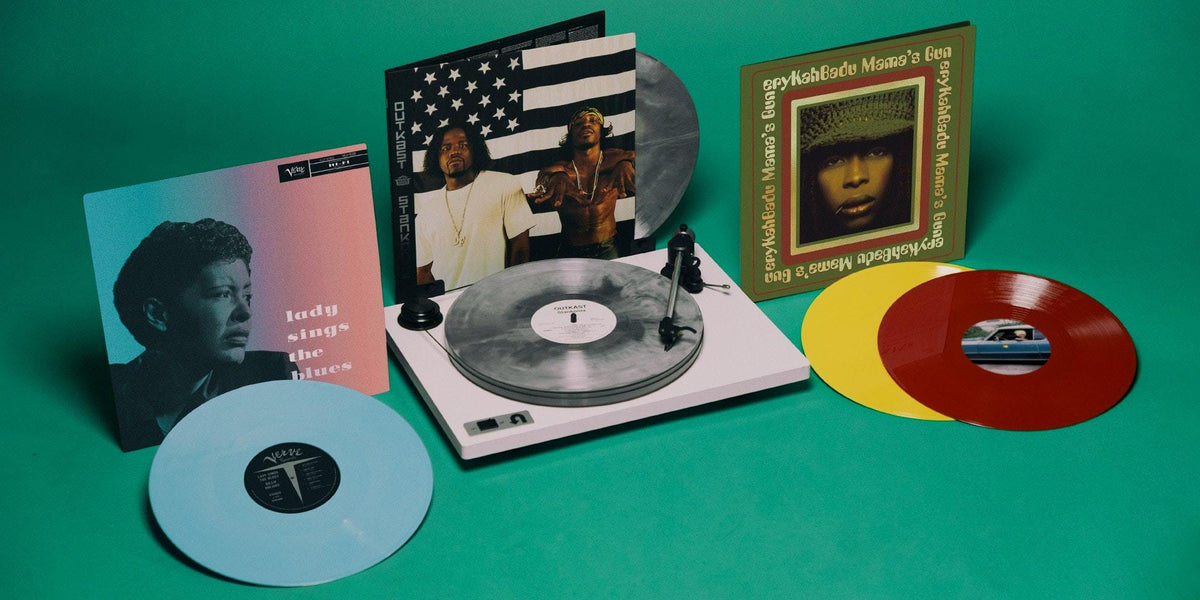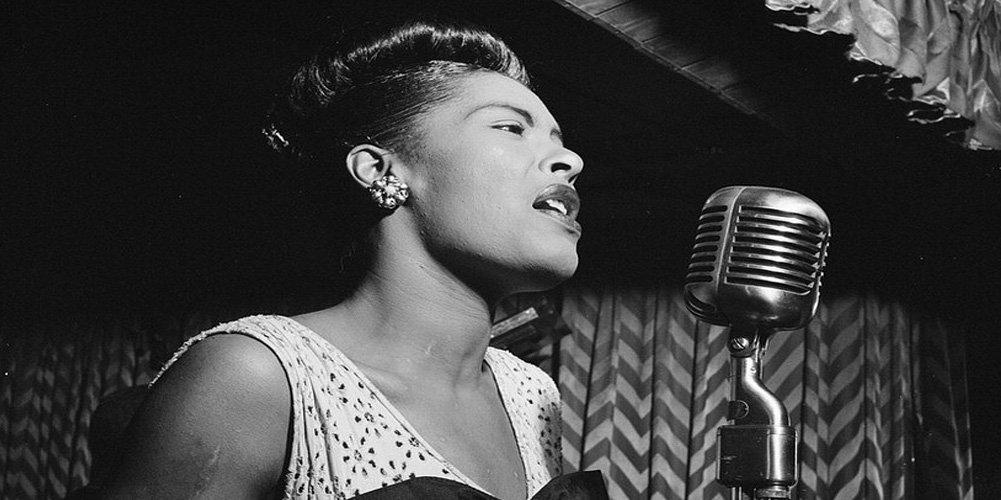‘Lady Sings The Blues’ Was Billie Holiday’s Meditation On Time
Read An Excerpt From Our Liner Notes For Our December Essentials Release
When Billie Holiday released Lady Sings the Blues in December 1956, she was not old, at age 41, but she had lived a long life. She had traveled far from the Baltimore of her youth, where she had washed her neighbors’ stoops and bathrooms to earn extra money for herself and her single mother, while singing along to the records of her heroes Bessie Smith and Louis Armstrong. She had come a long way from the girls’ reformatory where she had been sent at age nine, and from the traumas of sexual assault she had endured by age 12, and from her early star turns as a soloist with the greatest swing bands of the day—those led by Benny Goodman, Teddy Wilson, Count Basie, and Artie Shaw. Her first string of hits recorded under her own name, including “God Bless the Child” and “Trav’lin’ Light,” had been recorded two decades prior, and it had been nearly that long since she had positioned herself as America’s most striking protest singer by performing “Strange Fruit.” She had recorded several more hits on the Decca label throughout the 1940s and had enjoyed an energizing tour of Europe in 1954, but she had been trying to survive as a working musician without a cabaret card for nearly a decade, ever since the state had revoked her ability to play in clubs that served alcohol due to a drug possession charge that sent her to prison for a year in 1947.
Despite the album’s nod to her stage name, Lady Day, Lady Sings the Blues is not an autobiography in song so much as a meditation on memory and time. And, despite what Holiday’s grim visage in the cover portrait implies, it is not a work of tragic decline. Instead, it is a shrewd and complex work that asks what time gives, reveals, and takes away. In that sense, it is a fitting retrospective for a singer with an ingenious sense of timing — an artist who was celebrated not only for her affecting reedy timbre, but for her uncanny ability to sing so precisely behind — and around — the beat.
Holiday recorded Lady Sings in two parts: in New York in September of 1954 and in Los Angeles in June of 1956. Eight out of 12 tracks were songs she had cut several times over the years, including “Strange Fruit,” “Good Morning Heartache,” and “God Bless the Child.” The title track, an original composition by Holiday and pianist Herbie Nichols, was new. Three other songs were additions to her songbook first recorded by others in the 1930s: “Too Marvelous for Words,” “Willow Weep for Me,” and “I Thought About You.” Holiday’s accompanists were an all-star cast including, at the New York sessions, Charlie Shavers on trumpet, Tony Scott on clarinet, Wynton Kelly on piano, and Kenny Burrell on guitar; and, in Los Angeles, Harry Edison on trumpet, Bobby Tucker on piano, Chico Hamilton on drums, and Red Callender on bass. The men were no doubt eager to do their best work with a singer so adept at working with, and against, a band. Holiday loved good instrumentalists, and they all loved her.
Her song selection on Lady Sings, in addition to making the album a safe bet in terms of sales, gave Holiday a chance to revisit her own earlier works and her fans a chance to re-hear them. This meant not only hearing what time and experience were believed to have done to her, but how she had willfully and deliberately grown as a singer. Holiday’s voice in her later years has often been heard as a record whose grooves reveal a lifetime of drug use and hard living. And her sound did change, becoming harder around the edges and softer within. But if her memoir by the same title is to be believed, she thought she was singing better than ever. Anyone who doubts this, she says, should compare her earlier and later versions of songs like “Lover Come Back” and “Yesterdays”: “Listen and trust your own ears. For God’s sake don’t listen to the tired old columnists who are still writing about the good old days 20 years ago.”
By the 1950s, Holiday was not merely managing but reveling in her new vocal timbres and textures; her voice was an instrument she was putting to work. You can hear this in the title track, “Lady Sings,” when she leans into the acrid aspects of her voice on “when you get a bad start” and “when you and your man have to part” — grinding them with the grit of the blues. In that same verse, she moves quickly to other vocal signatures: her elegant corkscrew vibrato at the end of “cry” and “why”; her lilting “’cause I love him!” echoes the way she sings those words on her 1948 recording of “My Man.” The title song, like the record as a whole, collects Holiday’s past and present effects. She travels, if not “light,” then swiftly with them.
Whatever she had lost over the years, one thing she had gained was authority. The title track opens with the fanfare befitting jazz royalty: Lenny McBrowne’s drum roll, Tucker’s piano ostinato, Shavers’s toreador flourish. The drama settles quickly as the queen takes her seat in the circle of attendants. The song lyrics might seem like a straightforward lesson in the blues, but as they shuttle back and forth between tenses, they raise more questions than they answer. “Lady sings the blues, she’s got ’em bad… But now the world will know, she’s never gonna sing them no more.” As these statements oscillate from verse to chorus, one wonders, which is it? Are the blues a continuous, ongoing condition or a present episode on its way out? Similar questions arise with “Trav’lin’ Light”: The speaker first declares, with a bright fatalism, that “from now on, I’m traveling light,” but then brackets her solo sojourn with a hoped-for end date. “Some lucky night, he may come back again, so until then, I’m traveling light.” “Some Other Spring” is likewise driven by the imagination of a future that will be better than the present.
“Lady Sings” is ultimately less concerned with providing an authoritative definition of the blues than with showing how they come and go — how we build ourselves up to believe they are over, only to greet them when they come back (“Good Morning, Heartache,” Holiday sings a few tracks later). The insistence that the lady’s blues are over and done with is patently theatrical: Shavers and other members of the ensemble admit as much when they repeat their dramatic opening flourish at the end, as if to raise and lower a stage curtain. What’s more, the song’s beautiful staging implies that neither the song nor the album will give us “the real, behind-the-scenes Billie Holiday,” except insofar as the real story of Holiday’s life is a story of music — of rehearsal, performance, singing and singing again. The album takes its title from her stage name, after all — an honorific which, as Farah Jasmine Griffin notes, is not only once but twice removed from the girl born Eleanora Fagan who became Billie Holiday.
Holiday’s memoir, for all its revelations, is another strategic work of self-fashioning in which Holiday plays with and analyzes time. She co-wrote the book with William Dufty, a New York Post journalist who was married to her friend Maely Dufty. The book begins with a now famous statement: “Mom and Pop were just a couple of kids when they got married. He was eighteen, she was sixteen, and I was three.” Holiday’s biographers have cast doubt on her account—noting, for instance, that her parents never married—but the statement is a counterpart to Holiday’s vocal play with time and timing. Right away, she toys with the conventions of memoir. Holiday was there already, ahead of time. Timing works differently for Black families, forcing “a couple of kids” to grow up fast, and their children to join them in making a way through an often hostile world. “I was only thirteen,” Holiday tells us soon after, “but I was a hip kitty.”
Hip indeed, including to the ways racism and sexism themselves can warp time. “You can be up to your boobies in white satin, with gardenias in your hair and no sugar cane for miles, but you can still be working on a plantation,” she notes at the start of Chapter 11. The metaphor was very real to her: her own great-grandmother and grandfather had been enslaved. Of her own labor in the early ’40s, Holiday writes, “It wasn’t long before I was one of the highest-paid slaves around. I was making a thousand a week — but I had about as much freedom as a field hand in Virginia a hundred years before.” To revise my own phrasing from earlier: She might have seemed to travel far from her maid’s work in Baltimore, or the fieldwork of the enslaved, but the hauntings of Black life are persistent. The anti-lynching dirge “Strange Fruit” resonated with her, in part, because it reminded her of the racism her father Clarence Holiday had experienced as a jazz guitarist touring the U.S.
For all its shuttling back and forth between time, the record Lady Sings, like its literary counterpart, acknowledges there are some things you simply can’t (or don’t want to) recover. This is the lesson of the last song, “I Thought About You.” In this ballad, written by Jimmy Van Heusen and Johnny Mercer, Holiday sings of riding a train while thinking of a lover she has left behind. The heartfelt understatement she sings the song with illustrates Robert G. O’Meally’s claim about her late style: that she “retains the soul of the music without offering the consolation of sentimentality or needless decoration.” By the end of “I Thought About You,” she looks back at “the track, the one going back to you,” but seems to pronounce the distance impassable. The narrower range she brings to this recording dramatizes that sense of foreclosure, the way certain possibilities, like a receding train track, narrow with time.
“I’ve been told that nobody says the word ‘hunger’ like I do. Or the word ‘love,’” Holiday tells us in her memoir. Both the record and the book called Lady Sings the Blues express that hunger, as well as the persistence of love. That love was the driving force of Holiday’s career, whether or not she was talking or singing about it. It was there in her interaction with other musicians such as her beloved sax collaborator Lester Young; in her fierce respect for the tradition of Black music she did so much to advance; and in her devotion to her people that led her to tell the truth in “Strange Fruit.” So much of what happened to her was enmeshed with the love of her life, which was music. By the time she recorded Lady Sings, her life in music — shaped as it was by her life as a Black woman in America — had afforded her extraordinary opportunities at an incalculable price. Those experiences made their mark on her voice, but the sound of that voice tells us less about what she endured than about what she was able to do over time as a musical genius.
Emily J. Lordi is an Associate Professor of English at Vanderbilt University and the author of three books: Black Resonance: Iconic Women Singers and African American Literature; Donny Hathaway Live (a volume in the 33⅓ series); and The Meaning of Soul: Black Music and Resilience since the 1960s. Her essays on music and culture have appeared in such venues as T: The New York Times Style Magazine, The New Yorker online, and The Atlantic.
Related Articles
Join the Club!
Join Now, Starting at $36Pages






